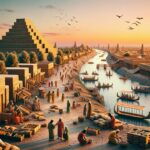Imagine a sun-drenched land nestled between the Tigris and Euphrates rivers, a region known as Mesopotamia. Here, in the face of scorching heat and unpredictable floods, the Sumerians forged a civilization that would forever change the course of history. Around 3500 BC, these resourceful people transformed small farming communities into powerful city-states, leaving behind an enduring legacy of innovation, culture, and ingenuity. This is the story of their remarkable journey.
Laying the Foundation: The Geography and Early Challenges of Sumer
Mesopotamia: The Cradle of Civilization
Mesopotamia, meaning “the land between the rivers,” provided fertile soil for agriculture but also presented significant challenges. The Tigris and Euphrates, while life-giving, were prone to devastating floods. The Sumerians had to find ways to harness the rivers’ power while mitigating the risks they posed.
Mastering the Waters: Irrigation and Agriculture
To combat the unpredictable nature of the rivers, the Sumerians developed sophisticated irrigation systems. They constructed canals, dikes, and reservoirs to control the flow of water, irrigate their fields, and protect their settlements from floods. This allowed them to cultivate barley, wheat, and other crops, producing a surplus of food that supported a growing population.
The Dawn of Cities: Urbanization and Specialization
The availability of surplus food led to a population boom and the rise of urban centers. Villages grew into walled cities, each with its own unique culture, government, and patron deity. As cities grew, so did specialization. People began to focus on specific crafts and trades, such as pottery, weaving, metalworking, and carpentry. This specialization led to increased efficiency and innovation and fueled the growth of the Sumerian economy.
The Pillars of Sumerian Society: Politics, Religion, and Innovation
The City-State System: Competition and Cooperation
Sumer was not a unified empire but a collection of independent city-states, each ruled by a king or governor. These city-states often competed for land, water, and resources, leading to frequent conflicts and warfare. However, they also engaged in trade and cultural exchange, fostering a sense of shared identity and cooperation. The Standard of Ur, an artifact dating back to around 2500 BC, depicts both scenes of peaceful trade and brutal warfare, offering a glimpse into the complex dynamics of Sumerian society.
Gods and Temples: The Role of Religion
Religion played a central role in Sumerian life. Each city-state had its own patron deity, and magnificent temples, known as ziggurats, were built to honor these gods. Priests held significant power and influence, managing temple affairs, overseeing religious ceremonies, and interpreting the will of the gods. Sumerians believed that the gods controlled the forces of nature and that it was essential to appease them through offerings and rituals.
Cuneiform and Innovation: A Legacy of Knowledge
The Sumerians were pioneers in many fields, developing innovations that would have a lasting impact on civilization. One of their most significant achievements was the invention of cuneiform, the earliest known writing system. Cuneiform allowed them to record their history, laws, literature, and religious beliefs. They also made significant advances in mathematics, astronomy, and engineering, laying the foundation for future scientific and technological advancements.
Decline and Legacy: The Enduring Impact of Sumer
Factors of Decline: Internal Strife and External Threats
Despite their achievements, the Sumerian city-states eventually declined and fell to outside invaders. Internal conflicts, environmental degradation, and the rise of powerful neighboring empires all contributed to their downfall. By around 2000 BC, Sumer was no longer a dominant force in Mesopotamia.
The Enduring Legacy: Shaping the Ancient World
Even though Sumerian civilization eventually faded, its legacy lived on. Their innovations in writing, mathematics, astronomy, and irrigation had a profound impact on subsequent civilizations in Mesopotamia and beyond. The Sumerians laid the foundation for many of the institutions and technologies that we take for granted today, making them one of the most influential cultures in human history. Their story serves as a testament to the resilience, creativity, and ingenuity of the human spirit.
The Interplay of Conflict and Cooperation in Sumerian City-State Development
How did the dynamics of conflict and cooperation shape the development of Sumerian city-states? Far from being isolated entities, these urban centers existed within a complex web of relationships, constantly negotiating their interests amidst competition for resources and shared cultural values.
Independent City-States: Seeds of Both Discord and Unity
Sumerian city-states, each governed by a lugal (king) and dedicated to its own patron deity, fiercely guarded their independence. Competition for fertile land, access to water, and control of trade routes frequently sparked conflicts, with city-states engaging in wars and raids to assert their dominance.
Cultural Bonds: Shared Beliefs and Practices
Despite their rivalries, Sumerian city-states also shared a common culture, language, and set of religious beliefs. This shared cultural foundation fostered a sense of unity and provided a basis for cooperation. Religious festivals, shared temple practices, and the exchange of goods and ideas helped to mitigate conflict and promote peaceful relations.
Treaties and Alliances: Formalizing Relationships
As Sumerian society evolved, so did its methods for managing inter-city relations. The development of cuneiform writing allowed for the creation of formal treaties and alliances, outlining agreements on trade, military support, and territorial boundaries. These agreements, often inscribed on clay tablets, provided a framework for cooperation and helped to prevent conflicts from escalating.
The Rise and Fall of Empires: Shifting Power Dynamics
Over time, some Sumerian city-states, such as Uruk and Ur, grew in power and influence, establishing empires that dominated their neighbors. While these empires brought a degree of stability and order, they also sowed the seeds of future conflict. Subjected city-states often rebelled against imperial rule, leading to renewed warfare and instability.
The Enduring Lesson: Balancing Competition and Collaboration
The story of Sumer is a testament to the complex interplay of conflict and cooperation in shaping civilization. While competition for resources and power often led to violence, the need for cooperation in managing the environment, promoting trade, and maintaining social order was equally important. The legacy of Sumer lies not only in its technological and cultural achievements but also in its demonstration of the enduring tension between ambition and collective action.
Key Takeaways:
- Sumerian city-states were characterized by both intense conflict and surprising cooperation.
- Shared cultural values and religious beliefs often formed the basis for cooperation.
- The development of cuneiform writing allowed for the formalization of alliances and treaties.
- The rise and fall of empires demonstrated the dynamic and ever-shifting balance of power between city-states.
- Sumer’s legacy highlights the complex and intertwined nature of cooperation and conflict in shaping civilizations.
Sumerian Society: Religion, Social Structure, and Daily Life
From 4100 to 1750 BCE, the Sumerian civilization flourished in Mesopotamia, laying the foundations for future societies with its innovative social structures and deeply ingrained religious beliefs. Understanding these elements provides crucial insights into Sumerian life and its lasting impact.
Independent City-States: A Decentralized Power Structure
Sumer was not a unified empire, but rather a collection of independent city-states, including Uruk, Ur, and Lagash. Each city-state functioned as a self-governing entity, complete with its own ruler, laws, and patron deity. Despite their independence, these city-states shared a common culture, language, and religious beliefs, which facilitated trade and cultural exchange.
The Central Role of Religion: Ziggurats and Priestly Power
Religion permeated every aspect of Sumerian life. The towering ziggurats, massive stepped pyramids, served as the focal point of each city-state, symbolizing the connection between the earthly and divine realms. Priests held immense power and influence, not only conducting religious ceremonies but also managing temple affairs, overseeing economic activities, and interpreting the will of the gods.
A Hierarchical Society: Social Stratification and Labor
Sumerian society was highly stratified, with a clear hierarchy that determined an individual’s social status and responsibilities. At the top were the rulers and priests, followed by merchants, landowners, artisans, laborers, and slaves. This social hierarchy was not rigid, and individuals could sometimes move up or down the social ladder through merit or circumstance.
Agricultural Foundation: The Tigris and Euphrates Rivers
Sumerian civilization was heavily dependent on agriculture, which thrived thanks to the fertile soil provided by the Tigris and Euphrates rivers. The Sumerians developed sophisticated irrigation systems to manage the rivers’ flow and irrigate their crops, ensuring a stable food supply for the growing population. However, this reliance on irrigation also made them vulnerable to environmental challenges, such as salinization and droughts.
A Lasting Legacy: Innovation and Influence
Despite its eventual decline, Sumerian civilization left an enduring legacy. Their innovations in writing, mathematics, astronomy, and law had a profound impact on subsequent civilizations in Mesopotamia and beyond. The Sumerians were pioneers in urban planning, irrigation, and social organization, laying the foundation for many of the institutions and technologies that we take for granted today.
Key Takeaways:
- Sumer was characterized by independent city-states, not a unified empire.
- Religion played a central role in Sumerian society, influencing social structures and governance.
- The social hierarchy was stratified, with religious and political elites at the top.
- Dependence on irrigation systems made Sumer vulnerable to environmental changes.
- Internal conflicts and external invasions contributed to Sumer’s ultimate decline.
- Sumer’s legacy significantly impacted subsequent civilizations in Mesopotamia and beyond.
Innovations in Sumer: Irrigation Systems and Urban Design
The Sumerians, inhabitants of ancient Mesopotamia, are recognized for their groundbreaking technological innovations. Among their most notable achievements were the development of sophisticated irrigation systems and advanced urban planning techniques. These advancements were pivotal in transforming the arid landscape into a flourishing civilization, enabling the growth of cities and supporting a thriving agricultural economy.
Key Takeaways:
- Sumerian Irrigation Systems, though seemingly basic by modern standards, represented a remarkable feat of engineering and community collaboration.
- These innovations were pivotal in the development of Sumerian Urban Centers.
- The systems, while successful, presented environmental challenges like salinization.
- Sumerian Urban Planning demonstrates an early understanding of city design and resource management.
- Lessons from Sumerian successes and failures remain relevant to contemporary sustainable agriculture.
Managing Water: A Lifeline for Agriculture
Mesopotamia, known as the “cradle of civilization,” presented both opportunities and challenges. The Tigris and Euphrates rivers provided a source of water for agriculture, but their unpredictable flooding patterns posed a constant threat to crops and settlements. To overcome this challenge, the Sumerians developed intricate irrigation systems that allowed them to control the flow of water, irrigate their fields, and protect their communities from floods.
Cooperation and Organization: Building and Maintaining Systems
The construction and maintenance of irrigation systems required a high degree of cooperation and organization. Sumerian communities worked together to build canals, dikes, and reservoirs, sharing labor and resources. This collective effort fostered a sense of social cohesion and helped to create a more stable and prosperous society.
Urban Centers: Planned Cities and Resource Management
The success of Sumerian irrigation systems enabled the growth of urban centers. Cities such as Uruk and Ur became thriving hubs of trade, culture, and innovation. Sumerian city planners carefully designed these urban centers to maximize access to water and resources, with well-organized streets, temples, and public spaces.
Challenges and Consequences: Environmental Impact of Innovation
While Sumerian irrigation systems were remarkably effective, they also had some unintended consequences. Over time, the accumulation of salts in the soil, known as salinization, reduced the fertility of the land and threatened agricultural productivity. The Sumerians were aware of this problem and attempted to address it through various techniques, such as crop rotation and drainage.
Enduring Lessons: Sustainable Practices
The Sumerian experience offers valuable lessons for contemporary sustainable agriculture. By carefully managing water resources, promoting community cooperation, and addressing environmental challenges, we can learn from the successes and failures of this ancient civilization and create more sustainable and resilient agricultural systems for the future.
How could they achieve such a large-scale project with minimal technology? These are questions that reinforce the Sumerians’ legacy.
1 https://press.rebus.community/historyoftech/chapter/technology_of_mesopotamia_irrigation/
- Discover the Best Ancient History Books: A Guide to Inclusive Narratives - August 6, 2025
- Unlock Ancient World History Textbook:A Deeper Understanding - August 6, 2025
- Discover History Alive Ancient World: Sumerian Rise to City-States - August 6, 2025















